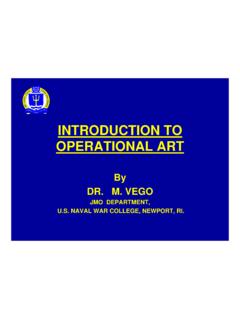Transcription of Naval War College Newport, R.I. Composite Warfare ...
1 Naval War College newport , Composite Warfare commander Doctrine in the Age of the Joint Task Force: A New Approach by Richard A. Brown Lieutenant commander , United States Navy A paper submitted to the Faculty of the Naval War College in partial satisfaction of the requirement of the Department of Joint Military Operations. The contents of this paper reflect my own personal views and are not necessarily endorsed by the Naval War College of the Department of the Navy Signature: 13 February 1998 B yard W. Russ ll Captain, United States Navy DTIC QUALITY INSPECTED 1 \<mw ^ DISTRIBUTION STATEMENT A Approved for public release; Distribution Unlimited Security Classification This Page: Unclassified REPORT DOCUMENTATION PAGE 1. Report Security Classification: UNCLASSIFIED 2. Security Classification Authority: 3. Declassification/Downgrading Schedule: ,. Distribution/Availability of Report: DISTRIBUTION STATEMENT A: APPROVED FOR PUBLIC RELEASE; DISTRIBUTION IS UNLIMITED.
2 5. Name of Performing Organization: JOINT MILITARY OPERATIONS DEPARTMENT 6. Office Symbol: Address: Naval WAR College 686 GUSHING ROAD newport , RI 02841-1207 8. Title (include security classification) : Composite Warfare commander Doctrine in the Age of the Joint Task Force: A New Approach fy} 9. Personal Authors: Richard A. Brown, Lieutenant commander , United States Navy of Keport: IN AL 11. Date of Keport: 13 February 1998 Count: 24 (including cover and this page) Notation: A paper submitted to the Faculty of the NWC in partial satisfaction of the requirements of the JMO Department. The contents of this paper reflect my own personal views and are not necessarily endorsed by the NWC or the Department of the Navy. 14. Ten key words that relate to your paper: Naval Command and Control, Composite Warfare commander , Joint Warfare commander doctrine : " the Sea" defined the Navy's strategic concept for the 21st century as one in which Naval forces, shaped for joint operations, will project power from the sea into the littoral regions of the globe.
3 However, the Navy has not yet evolved its command and control doctrine Lo support its new strategic concept. The Composite Warfare commander (CWC) doctrine, established to effectively manage blue water Naval operations, continues to be the basis for Naval Command and Control in the littoral and joint environments. This doctrine does not, however, transition well into joint or combined operations nor does it adequately address command and control problems associated with a Navy-Marine Task Force, comprised of a Carrier Battle Group (CVBG) and an Amphibious Ready Group (ARG), operating in the littoral. The development of a Joint Warfare commander doctrine and the restructuring of the Navy-Marine Task Force command organization will retain the benefits of CWC, support the Navy's new strategic concept and allow the Navy-Marine Task Force to seamlessly transition to or establish a Joint Task Force. / Availability of Abstract: Unclassified X Same As Rpt DTIC Users Security Classification: UNCLASSIFIED of Responsible Individual: CHAIRMAN, JOINT MILITARY OPERATIONS DEPARTMENT : 841-6461 Symbol: Security Classification of This Page: Unclassified TABLE OF CONTENTS Abstract Table of Figures i Introduction 1 Naval Command and Control in the 21st Century 2 Amphibious Command and Control 3 Joint Warfare commander Doctrine 5 1.
4 Building Block Approach 5 2. Expanding the Basic JWC Organization 8 3. Joint Warfare commander Doctrine in a Joint Force 10 Value of JWC to the Joint Force commander 13 Recommendations 14 1. Evolving Toward 21st Century Operations 14 2. Joint Vision 2010 17 Conclusion 18 Bibliography 19 ABSTRACT " the Sea" defined the Navy's strategic concept for the 21st century as one in which Naval forces, shaped for joint operations, will project power from the sea into the littoral regions of the globe. However, the Navy has not yet evolved its command and control doctrine to support its new strategic concept. The Composite Warfare commander (CWC) doctrine, established to effectively manage blue water Naval operations, continues to be the basis for Naval Command and Control in the littoral and joint environments. This doctrine does not, however, transition well into joint or combined operations nor does it adequately address command and control problems associated with a Navy-Marine Task Force, comprised of a Carrier Battle Group (CVBG) and an Amphibious Ready Group (ARG), operating in the littoral.
5 The development of a Joint Warfare commander doctrine and the restructuring of the Navy-Marine Task Force command organization will retain the benefits of CWC, support the Navy's new strategic concept and allow the Navy-Marine Task Force to seamlessly transition to or establish a Joint Task Force. TABLE OF FIGURES Figure 1: Navy-Marine Task Force Organized as a Joint Task Force 6 Figure 2: JTF under a Fleet commander /Navy-Marine Task Force providing majority of forces 9 Figure 3: Joint Force Organization 12 in INTRODUCTION " the Sea" defined the Navy's strategic concept for the 21st century as one in which Naval forces, shaped for joint operations, will project power from the sea into the littoral regions of the globe. However, the Navy has not yet evolved its command and control doctrine to support its new strategic concept. The Composite Warfare commander (CWC) doctrine, established to effectively manage blue water Naval operations, continues to be the basis for Naval Command and Control in the littoral and joint environments.
6 This doctrine does not, however, transition well into joint or combined operations nor does it adequately address command and control problems associated with a Navy-Marine Task Force, comprised of a Carrier Battle Group (CVBG) and an Amphibious Ready Group (ARG), operating in the littoral. The development of a Joint Warfare commander doctrine and the restructuring of the Navy-Marine Task Force command organization will retain the benefits of CWC, support the Navy's new strategic concept and allow the Navy-Marine Task Force to seamlessly transition to or establish a Joint Task Force. Before developing a new doctrine, fundamental principles must be established on which Naval Command and Control should be founded given the strategic concept formulated in " From the Sea". Additionally, inadequacies of current CVBG- ARG command relationships must be presented and alternatives formulated. Utilizing 21st century command and control requirements in conjunction with an alternative amphibious command structure, the Joint Warfare commander doctrine will be presented.
7 This paper will then detail how Joint Warfare commander doctrine can easily transition from operations in which the Navy-Marine Task Force serves as the enabling Joint Task Force to operations in which it is part of a much larger joint force. Once the Joint Warfare commander doctrine has been developed, its benefits to the Joint Force commander will be presented. Finally, recommendations will be provided for developing, implementing, promulgating and evolving Naval Command and Control doctrine based on the JWC concept. Naval COMMAND AND CONTROL IN THE 21ST CENTURY Throughout the Cold War, the U. S. Navy developed its Command and Control doctrine to support its blue water strategy. However, as Naval forces become more the "primary channel through which the entire range of military capabilities can be exercised and demonstrated in multinational operations, then they have to be better able to do this."1 The Navy will "have to tear down some of the assumptions regarding specialization that have grown up over the years" and operate jointly not just conduct joint " From the Sea" states that "no single military service embodies all of the capabilities needed to respond to every situation and threat.
8 " Although the Navy-Marine Task Force may not embody all of the capabilities required to respond to a crisis, it is likely that it will be the CINC's first credible force to arrive on the scene. However, because of the unique environment from which a Navy-Marine Task Force operates, certain principles, specific to operating Naval forces at sea, must remain inherent in the Naval Command and Control doctrine of the 21st century. They are: 1. Unity of command 2. Delegation of authority 'Admiral William A. Owens, USN (ret), " Naval Voyage to an Uncharted World," Proceedings. December 1994, p. 34. 2 Ibid. 3 the Sea, p. 7. 2 3. Centralized planning/decentralized execution 4. Options for close control to control by negation 5. Tempo and firepower 6. Simultaneous combined arms operations 7. Flexibility4 The validity of these principles is well accepted throughout the Naval service. However, given that today's Navy-Marine Task Forces will more probably be the enabling force at the scene of a crisis or become part of an existing Joint Task Force, Naval Command and Control doctrine must also 1.
9 Integrate other service components into the Navy-Marine Task Force at any time during an operation; 2. Seamlessly integrate the Navy-Marine Task Force into an established Joint Task Force; 3. Mirror accepted Joint Task Force command structures; 4. Minimize reorganization within the Navy-Marine Task Force once operations are expanded. A revised Naval Command and Control doctrine which embodies these principles must also clearly delineate the command relationships resulting from putting ground forces ashore. AMPHIBIOUS COMMAND AND CONTROL A major stumbling block to revising Naval Command and Control for joint operations is the relationship between the CVBG and the ARG. Naval doctrine has slowly evolved such that unity of command is not maintained when a CVBG and an ARG are conducting amphibious operations. Specifically, doctrine has evolved such that the ARG commander is the supported commander and the CVBG commander is the supporting commander .
10 In today's environment, when it is likely to be employed as one 4 Naval Doctrine Command, Naval Expeditionary Task Force Command and Control. Julyl, 1996, p. 3-1-1. force, there should be no distinction within the Navy-Marine Task Force between supported and supporting commanders. The Navy-Marine Task Force should respond as one force, operating under one commander . Unity of command dictates that the senior Naval officer in command be the commander of the Amphibious Task Force (CATF). The Amphibious Task force is thus analogous with the Navy-Marine Task Force and not the Amphibious Ready Group. Given the example of a Navy-Marine Task Force comprised of one CVBG and one ARG, the Battle Group commander should be CATF. Although recent papers, such as " Naval Expeditionary Task Force Command and Control" recognize the CVBG commander as CATF, they fail to expand the concept of unity of command outside of a one CVBG and one ARG task force.



















